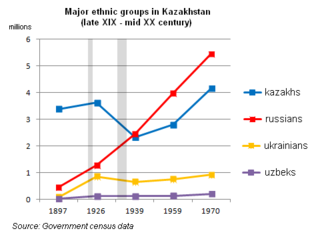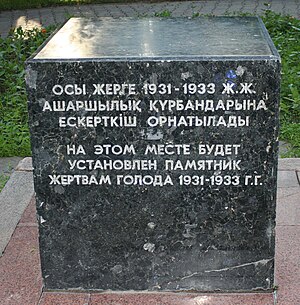Kazakh famine of 1930–1933

The Kazakhstan famine of 1932-1933, described as Kazakh katastrophe by Robert Conquest[1], was part of the Soviet famine of 1932–33. While Ukraine was worst affected, the famine also spread to Kazakhstan and other areas. [2] Kazakhs were most severely affected by the Soviet famine in terms of percentage of people who died (approximately 38%).[3] Around 1.5 million (or possibly as many as 2.0–2.3 million) people died in Kazakhstan of whom 1.3 million were ethnic Kazakhs.[4]
It is known in Kazakshan as "Goloshchekin genocide" (Kazakh: Голощекиндік геноцид),[5] in reference to Filipp Goloshchyokin, who carried out the Sovietization of Kazakhstan at the time.
Taking into an account the Kazakh famine of 1919–1922, in 10-15 years Kazakh lands lost more than half of its population due to the actions of the Soviet power.[6]
Consequences

The famine made Kazakhs a minority in their own republic, and not until the 1990s did Kazakhs become the largest group in Kazakhstan again. Before the famine, around 60% of the republic's population where Kazakhs, but after the famine, only around 38% of the population were Kazakhs.[7][8][9][10]
See also
Further reading
- Conquest, Robert, «The Harvest of Sorrow: Soviet Collectivization and the Terror — Famine», (Edmonton: The University of Alberta Press in Association with the Canadian Institute of Ukrainian Studies, 1986).
- Sahni, Kalpana. Crucifying the Orient : Russian orientalism and the colonization of Caucasus and Central Asia. Bangkok : White Orchid Press, 1997
- I. Ohayon, La sédentarisation des Kazakhs dans l’URSS de Staline, collectivisation et changement social, Paris, maisonneuve et Larose, 2006 Template:Fr-icon
References
- ^ Robert Conquest, The Harvest of Sorrow: Soviet Collectivization and the Terror-famine, 1987
- ^ Pannier, Bruce (2007-12-28). "Kazakhstan: The Forgotten Famine". Rferl.org. Retrieved 2015-07-09.
- ^ NICCOLÒ PIANCIOLA (2001). "The Collectivization Famine in Kazakhstan, 1931–1933". Harvard Ukrainian Studies. 25. Harvard Ukrainian Research Institute: 237–251. Retrieved 2015-07-09.
- ^ Volkava, Elena (2012-03-26). "The Kazakh Famine of 1930-33 and the Politics of History in the Post-Soviet Space". Wilson Center. Retrieved 2015-07-09.
- ^ Қазақстан тарихы: Аса маңызды кезеңдері мен ғылыми мәселелері. Жалпы білім беретін мектептің қоғамдык- гуманитарлық бағытындағы 11-сыныбына арналған оқулық / М.Қойгелдиев, Ә.Төлеубаев, Ж.Қасымбаев, т.б. — Алматы: «Мектеп» баспасы, 2007. — 304 бет,суретті. ISBN 9965-36-106-1
- ^ "Валерий Михайлов: Во время голода в Казахстане погибло 40 процентов населения"
- ^ Татимов М. Б. Социальная обусловленность демографических процессов. Алма-Ата,1989. С.124
- ^ Қазақстан тарихы: Аса маңызды кезеңдері мен ғылыми мәселелері. Жалпы білім беретін мектептің қоғамдык- гуманитарлық бағытындағы 11-сыныбына арналған оқулық / М.Қойгелдиев, Ә.Төлеубаев, Ж.Қасымбаев, т.б. — Алматы: «Мектеп» баспасы, 2007. — 304 бет,суретті. ISBN 9965-36-106-1
- ^ http://world.lib.ru/p/professor_l_k/070102_koval_drujba.shtml - "Запомнил и долю казахов в пределах своей республики - 28%. А за тридцать лет до того они составляли у себя дома уверенное большинство"
- ^ http://www.jstor.org/discover/10.2307/41036834?uid=3738984&uid=2129&uid=2&uid=70&uid=4&sid=21104012154341
